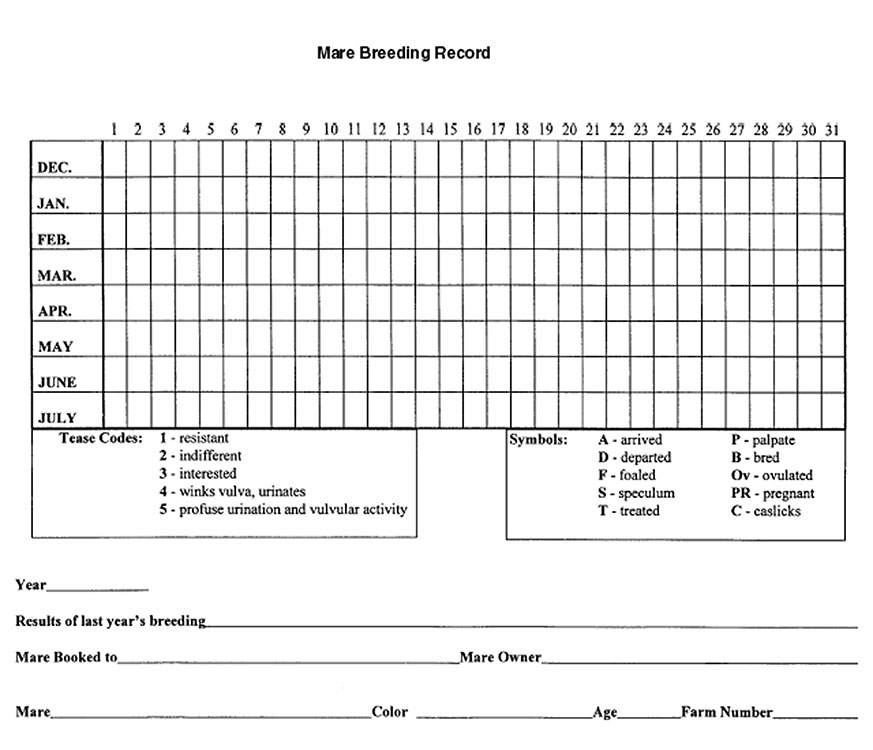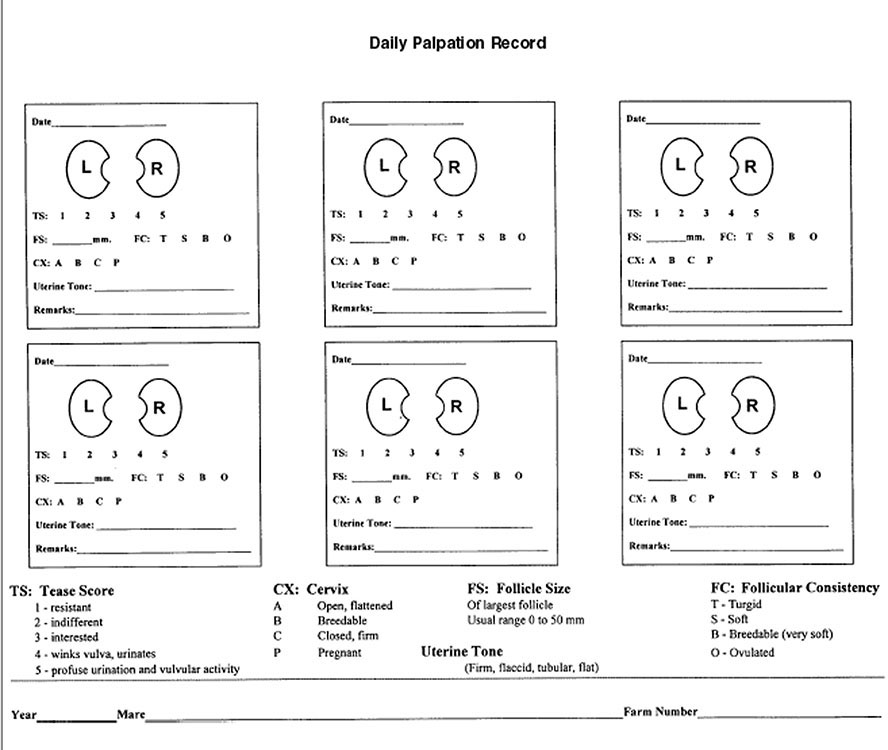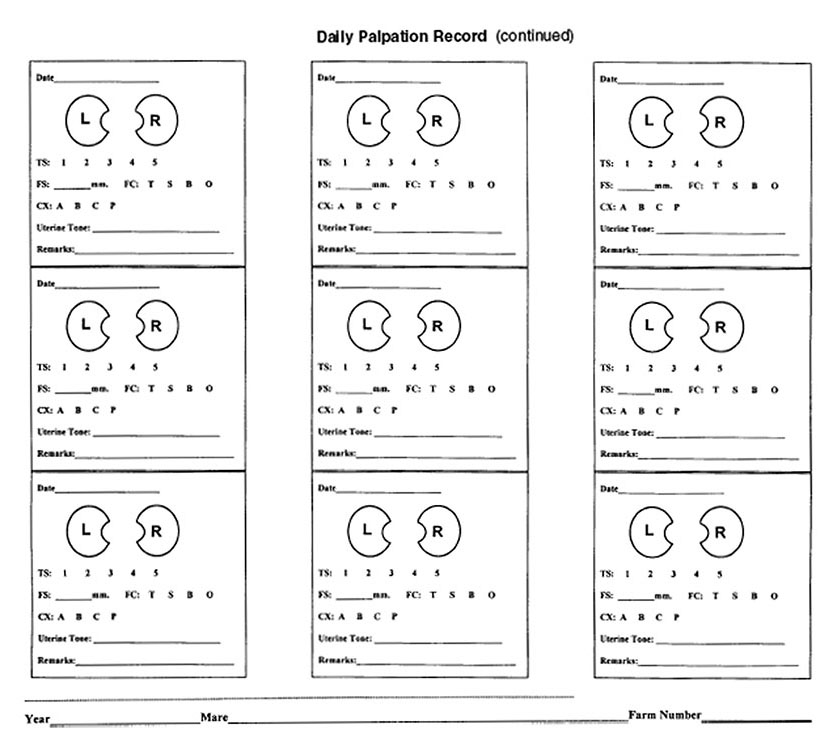Recordkeeping for Horse Breeding Activities
On horse farms, the breeding shed is perhaps the most important place for accurate recordkeeping. Records are needed for breeding management, estimating foaling dates and evaluating breeding performance. Record evaluation is essential in decision making.
The type and detail of records depends on the management of breeding practices on each farm. Farms that breed a small number of mares by live cover without palpation or ultrasound will have different needs than farms breeding large numbers using artificial insemination and palpation or ultrasound. The examples provided in this publication will assist in designing records for your farm.
Mare Records
Breeding Records
Records should include the year, the name, color, and age of the mare, and the farm number. On large farms, it is a common practice to assign individual mares a numbered neck band. Neck bands help in quick and accurate identification of each mare. Records should also identify the stallion the mare is booked to, the mare’s owner and previous breeding results.
Each mare should have a record to document changes in breeding status and procedures. It should contain a daily calendar to record this information.
Symbols are used on records to indicate breeding activities. Dates of arrival to and departure from the farm determine mare care charges. Foaling dates indicate the expected time the mare will be in foal heat or subsequent cycles. Recording the mare’s breeding procedures assists in scheduling heat detection, breeding, pregnancy determination and veterinary treatments. In addition, recording the dates she was bred provides information to estimate time of foaling.
Mares cycle about every 22 days during the breeding season. As ovulation nears, most mares are more receptive to stallions. This heat period lasts three to seven days. A mare’s sexual receptivity is documented with teasing codes. The codes rate mares on a scale of 1 to 5. A ‘1’ indicates a mare is resistant to the teaser stallion and a ‘5’ means she shows strong, visible signs of heat. Recording the mare’s response to teasing determines her heat cycles and time of breeding.
Palpation and ultrasound provide additional documentation to determine ovulation and pregnancy. The use of symbols is demonstrated in Figure 1 and explanations are provided on page 4. An ‘F’ indicates that the mare foaled on February 1. The teasing response was recorded February 8, 10, 12 and 14. The teasing code ‘4,’ recorded on February 10 and 12, indicates the mare is ready to be bred. The ‘B’ notes that the mare was bred on February 10 and 12. The ‘P’ indicates the mare was palpated on the 10th, 12th and 14th. The ‘Ov’ indicates that she ovulated sometime after palpation on the 12th. An initial pregnancy check on March confirmed she was pregnant (PR). The ‘C’ documents a Caslicks procedure was performed on March 15.
Figure 1. Portion of a breeding record
Daily Palpation Record
Commercial breeding enterprises use palpation or ultrasound to determine the condition of the reproductive tract, follicular status, and pregnancy. The palpation record should clearly indicate the tease score, cervical tone and shape, uterine tone and condition, and follicle size and location. Like the other records, symbols are used to identify these items on the palpation record (on page 5).
During estrus, the equine uterus is relaxed with little tone and, when palpated, the uterine horns feel flat when compressed. During diestrus, the horns feel more tubular and firm. In most mares, uterine tone increases greatly during pregnancy. The palpation record allows for short narrative notes indicating tone and shape. An ultrasound determines the presence of endometrial folds, intralumenal fluids and the shape of the uterine horns.
Rectal palpation and ultrasound of the cervix provide indications of variation in cervical tone. When pregnant or diestrual, the cervix is tightly closed, very firm, and easily distinguished. During heat, the cervix gradually begins to flatten and lose tone. Maximum relaxation occurs as ovulation approaches. Cervical shape and tone should be recorded with written notation or score.
Rectal palpation and ultrasound also provide documentation of follicular consistency and size. A dominant follicle is expected to increase in size as ovulation approaches, typically 2 to 3 mm a day, but can be as high as 5mm per day or exhibit no growth for three to four days. Monitoring the presence and progression in follicle size assists in determining a time for insemination and recognizing patterns within mares.
Figure 2 is a portion of a daily palpation record. Notations are explained on the palpation record on page 5. The notation ‘TS: 4’ indicates that the mare was very receptive to the stallion when teased on February 10. Markings on the ovary diagrams indicate a dominate follicle of 40 mm on the left ovary (FS: 40 mm) and several small follicles on the right. The cervix score (CX: A) indicates the cervix was very flat. Narrative comments about the uterus show that it had little tone. Remarks indicate the mare was inseminated.
Figure 2. Portion of a Palpation Record
Other Breeding Farm Records
In addition to breeding and palpation reports, each mare entering the farm should have a receiving record to identify breeding and management history. Information recommended is mare and owner identification; recent vaccination and deworming history; health status of the mare and foal; a current, negative Coggins test; history of any foaling difficulty; and treatments for reproductive diseases. Additionally, handling problems and a recent feeding history will assist in her management on the farm. This record should be sent with the breeding contract and returned when the mare arrives at the breeding farm.
Stallion Records
Farms using live cover record the number of daily breedings for each stallion. Those using artificial insemination document semen evaluation. Semen evaluation records include semen volume, concentration, morphology and motility. These factors determine the semen volume necessary for an insemination dose. Motility, the number of moving sperm, is estimated using a microscope. Concentration is measured by a spectrophotometer. A morphological assessment estimates the percent of abnormal sperm.
Review of daily records establish a stallion’s average semen production throughout the breeding season. Knowing the expected level of semen production determines the number of mare bookings. Unexpected changes in quantity or quality of semen can indicate health problems that need immediate attention.
Using Records for Breeding Activity Evaluation
The goal of a breeding farm is to produce live foals. To determine whether the goal was reached several ratios are calculated from breeding records.
The most routine evaluation is pregnancy rate. This is the number of mares pregnant on a specific day, divided by the number bred. Pregnancy rate can be determined from one ovulatory period or on the total breeding season.
For example, early pregnancy checks of 20 mares revealed that 17 had embryos and three were open. The pregnancy rate would be 17, divided by 20, multiplied by 100.
Pregnancy rate = (17/20) x 100 = 85% pregnant.
The number of cycles per pregnancy further defines breeding efficiency. A low average number of cycles is more efficient. For example, a review of records showed that 10 mares were settled on one heat cycle, five mares settled after two, and two mares settled after three cycles.
Number of cycles per pregnancy = [(10 x 1) + (5 x 2) + (2 x 3)] divided by 17.
Average cycles per pregnancy = (10 + 10 + 6) / 17 = 1.5 cycles per pregnancy.
Foaling rates are the percent of matings that produce a live foal. It is determined by dividing the number of live foals by the number of mares bred. For example, foaling rate would be 75 percent if 15 of 20 mares bred produced foals.
Foaling rate = (15/20 X 100) = 75%.
Foaling rate provides an overall ratio of efficiency, but it does not determine what most influenced the overall ratio. More specific ratios, such as pregnancy loss rate, embryo loss rate, fetal loss rate, and stillbirth fetal loss rate, identify differences at specific times of gestation.
Pregnancy loss rate is the number of mares not foaling, divided by the ones pregnant on the first pregnancy check, usually around day 20.
Embryo loss rate is the number not pregnant at end of embryo stage (e.g., day 40), divided by the number pregnant on a specific day (e.g., day 20).
Fetal loss rate is the number of mares not foaling, divided by the number pregnant on a specific day (e.g., day 40).
Stillbirth rate is the fetal loss rate near term (e.g., 300 days).
Summary and Recommendations
- Records provide information for decisions on which mares to breed and when a mare is most likely to conceive if bred.
- Records from a mare’s past breeding season aid in preparing her for breeding and allow the manager to more accurately predict her breeding status.
- Records are used to evaluate the level of success in producing foals and the need for changes in breeding management activities.
- Records should provide accurate information that is clearly understood and readily accessible.
- For clarity and consistency, it is recommended that one person be responsible for recordkeeping during the breeding season.
- The design of records should allow ease of cross referencing from one to another (i.e., breeding record referenced to palpation record).
- The design should minimize time spent recording, without jeopardizing accuracy and detail.
- Larger farms should strongly consider computer programs for recordkeeping.
Figure 3.
Figure 4.
Figure 5.
Kris Hiney
Extension Equine Specialist





